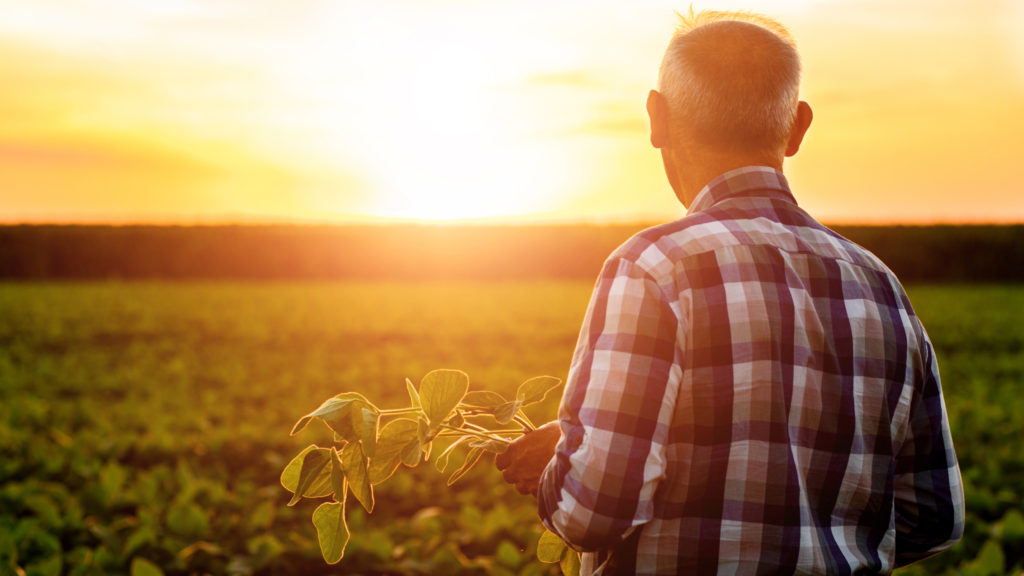UN Climate Report: Change Land Use or Risk Hunger
Seth Borenstein and Jamey KeatenAugust 8, 2019

In this undated file photo, a farmer stands in soybean field examing a crop. (Adobe)
GENEVA — Human-caused climate change is dramatically degrading the Earth’s land and the way people use the land is making global warming worse, a new United Nations scientific report says. That creates a vicious cycle which is already making food more expensive, scarcer and less nutritious.
“The cycle is accelerating,” said NASA climate scientist Cynthia Rosenzweig, a co-author of the report. “The threat of climate change affecting people’s food on their dinner table is increasing.”
But if people change the way they eat, grow food and manage forests, it could help save the planet from a far warmer future, scientists said.
Earth’s land masses, which are only 30% of the globe, are warming twice as fast as the planet as a whole. While heat-trapping gases are causing problems in the atmosphere, the land has been less talked about as part of climate change. A special report, written by more than 100 scientists and unanimously approved by diplomats from nations around the world Thursday at a meeting in Geneva, proposed possible fixes and made more dire warnings.
“The way we use land is both part of the problem and also part of the solution,” said Valerie Masson-Delmotte, a French climate scientist who co-chairs one of the panel’s working groups. “Sustainable land management can help secure a future that is comfortable.”
Scientists at Thursday’s press conference emphasized both the seriousness of the problem and the need to make societal changes soon.
“We don’t want a message of despair,” said science panel official Jim Skea, a professor at Imperial College London. “We want to get across the message that every action makes a difference.”
Still the stark message hit home hard for some of the authors.
“I’ve lost a lot of sleep about what the science is saying. As a person, it’s pretty scary,” Koko Warner, a manager in the U.N. Climate Change secretariat who helped write a report chapter on risk management and decision-making.
The report said climate change already has worsened land degradation, caused deserts to grow, permafrost to thaw and made forests more vulnerable to drought, fire, pests and disease. That’s happened even as much of the globe has gotten greener because of extra carbon dioxide in the air. Climate change has also added to the forces that have reduced the number of species on Earth.
And the future could be worse.
“The stability of food supply is projected to decrease as the magnitude and frequency of extreme weather events that disrupt food chains increases,” the report said.
In the worst-case scenario, food security problems change from moderate to high risk with just a few more tenths of a degree of warming from now. They go from high to “very high” risk with just another 1.8 degrees Fahrenheit (1 degree Celsius) of warming from now.
“The potential risk of multi-breadbasket failure is increasing,” NASA’s Rosenzweig said. “Just to give examples, the crop yields were effected in Europe just in the last two weeks.”
Scientists had long thought one of the few benefits of higher levels of carbon dioxide, the major heat-trapping gas, was that it made plants grow more and the world greener, Rosenzweig said. But numerous studies show that the high levels of carbon dioxide reduce protein and nutrients in many crops.
If people change their diets, reducing red meat and increasing plant-based foods, such as fruits, vegetables and seeds, the world can save as much as another 15% of current emissions by mid-century. It would also make people more healthy, Rosenzweig said.
The science panel said they aren’t telling people what to eat because that’s a personal choice.
Reducing food waste can fight climate change even more. The report said that between 2010 and 2016, global food waste accounted for 8% to 10% of heat-trapping emissions.
“Currently 25%-30% of total food produced is lost or wasted,” the report said. Fixing that would free up millions of square miles of land.
With just another 0.9 degrees F of warming (0.5 degrees C), which could happen in the next 10 to 30 years, the risk of unstable food supplies, wildfire damage, thawing permafrost and water shortages in dry areas “are projected to be high,” the report said.
At another 1.8 degrees F of warming (1 degree C) from now, which could happen in about 50 years, it said those risks “are projected to be very high.”
Most scenarios predict the world’s tropical regions will have “unprecedented climatic conditions by the mid-to-late 21st century,” the report noted.
Agriculture and forestry together account for about 23% of the heat-trapping gases that are warming the Earth, slightly less than from cars, trucks, boats and planes. Add in transporting food, energy costs, packaging and that grows to 37%, the report said.
But the land is also a great carbon “sink,” which sucks heat-trapping gases out of the air.
From about 2007 to 2016, agriculture and forestry every year put 5.7 billion tons (5.2 billion metric tons) of carbon dioxide into the air but pulled 12.3 billion tons (11.2 billion metric tons) of it out.
“This additional gift from nature is limited. It’s not going to continue forever,” said study co-author Luis Verchot, a scientist at the International Center for Tropical Agriculture in Colombia. “If we continue to degrade ecosystems, if we continue to convert natural ecosystems, we continue to deforest and we continue to destroy our soils, we’re going to lose this natural subsidy.”


